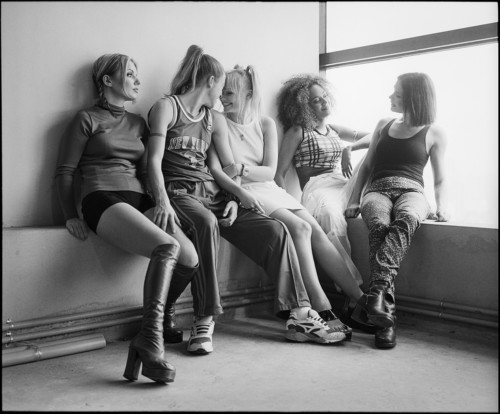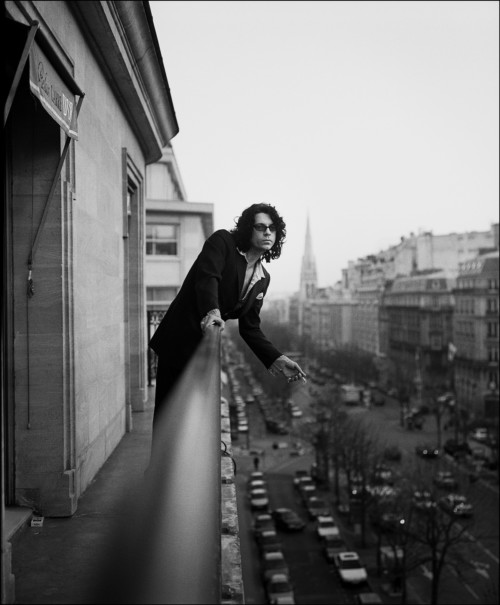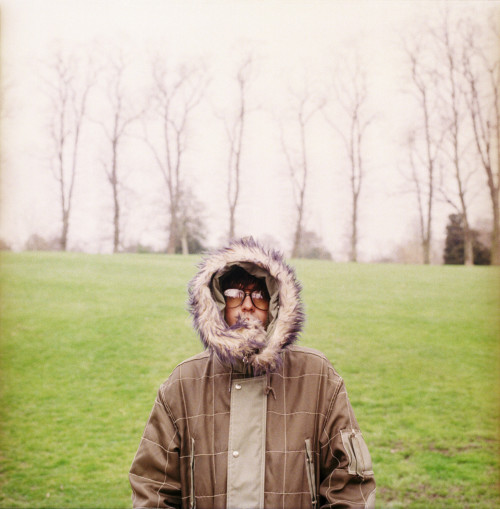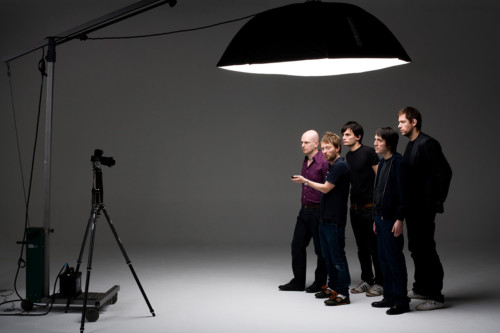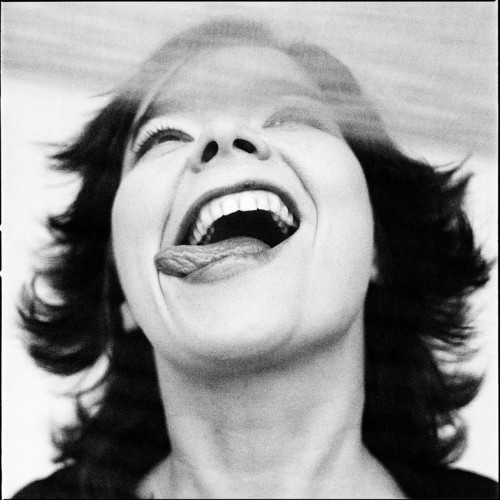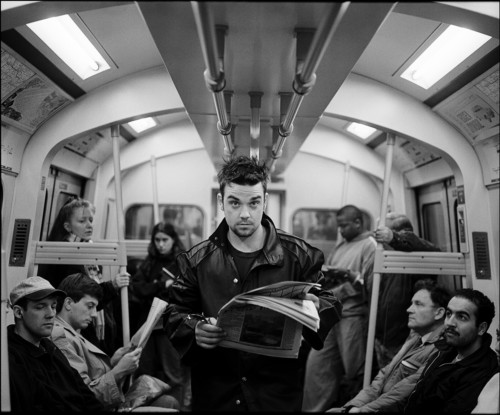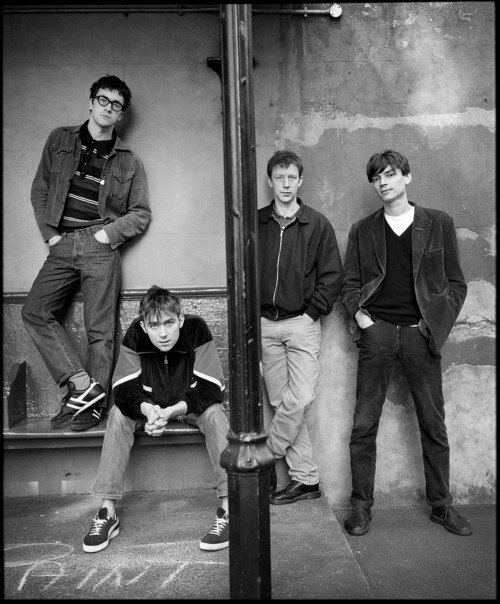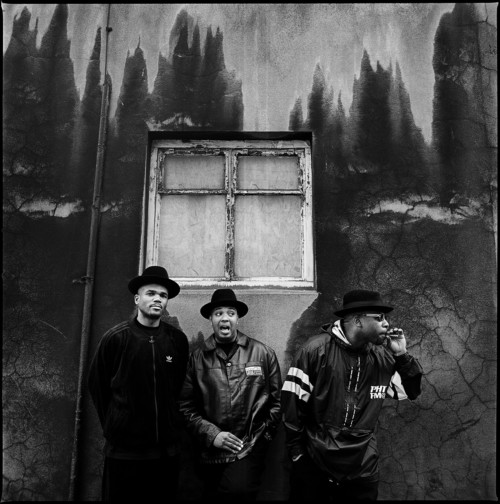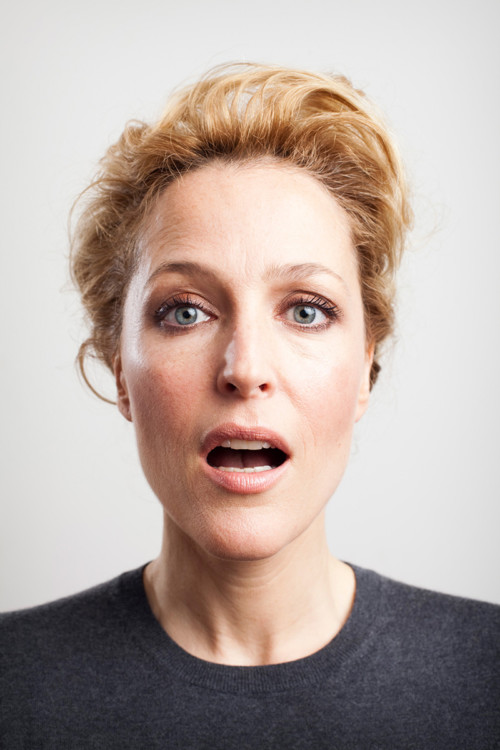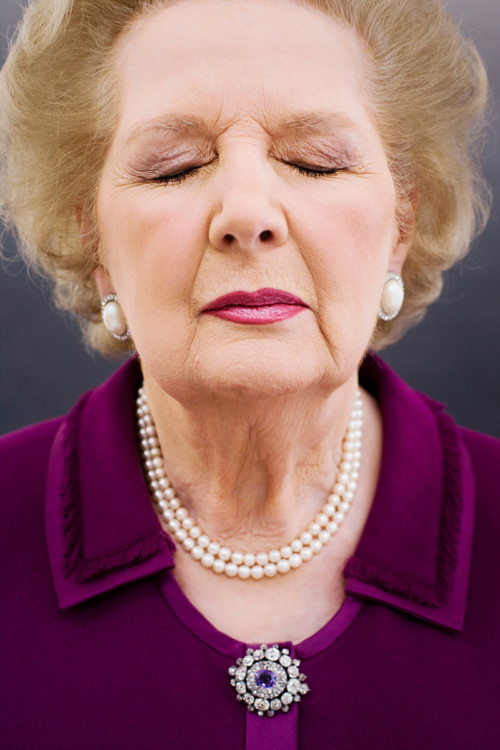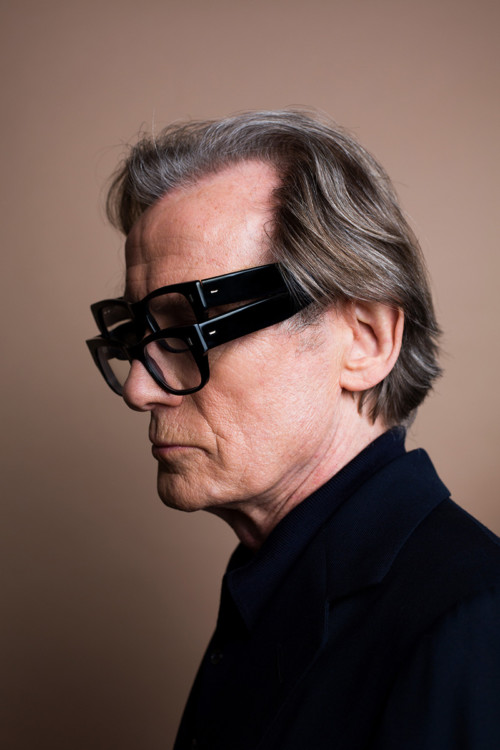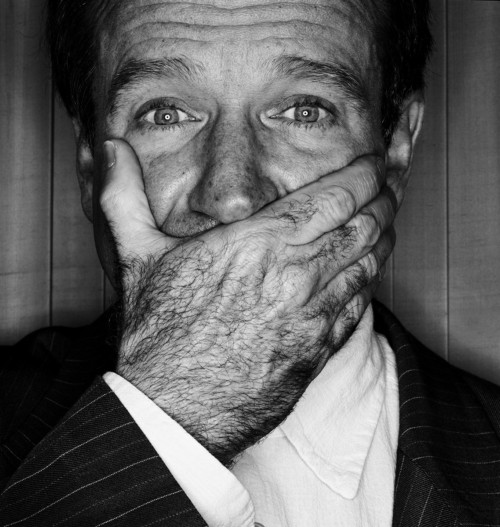-
Harry Borden: The Spice Girls, Bangkok (1996)
£ 625 – £ 5,800The Spice Girls, Bangkok 1996. L to R: Geri Halliwell, Melanie Chisholm, Emma Bunton, Melanie Brown, and Victoria Adams (later Victoria Beckham) Harry Borden photographed the Spice girls on four occasions and this is his favourite Spice Girls image. Harry explains: "The location for the shoot was a half-built tower block in the centre of Bangkok, chosen because their record company’s offices were on a lower floor of the building. After shooting a number of pictures on the roof, we came down to the office and they sat down, exhausted by the heat. I immediately saw that this scene would make a much better picture than the others I’d taken. So I quickly asked them to hold their positions and shot a few frames, using my Fujifilm 6x7 rangefinder, with Kodak Tri-X film." "There’s a wonderful line going through it, partly because of the way they are touching or linking arms, and the interplay between the two pairs of girls looks very natural. I also like the variation in light; Geri, on the left, is lit like a figure from a Renaissance painting, while Victoria on the other side of the frame is backlit. The fact that Geri is looking slightly distant is also appropriate; she was older and more worldly than the others and went on to leave the group in 1998. The picture only came about because I was alive to the situation and didn’t switch off - and shows that sometimes magic happens when you’re not trying too hard. A print is now in the permanent collection of The National Portrait Gallery." Available in a choice of physical size options. Please ask for framing options. Please allow 2-3 weeks between order and delivery for an unframed photograph. Framing adds 2-3 weeks. -
Harry Borden: Michael Hutchence, Paris (1997)
£ 625 – £ 5,800Michael Hutchence pauses for a cigarette on the balcony of his hotel on the Champs Élysées, Paris, March 1997 This portrait of Michael Hutchence has become one of Harry Borden's best known images. Harry recalls a memorable week spent with the tragically short-lived INXS singer: "In March 1997, I was asked by The Observer to photograph him in Paris, where he was promoting INXS’s latest single, "Elegantly Wasted". It was a great commission and involved me staying at a really nice hotel on the Champs-Élysées for a week – where Hutchence was also staying. However, as we had to fit the shoots around him doing interviews and performing on pop shows, there was a lot of waiting around. I saw him perform the new single over and over again. He was, at that time, 37 years old and had been in the business for more than 20 years, but was still a mesmerising performer and had a lithe, panther-like quality. He had a great voice and his on-stage presence helped make the band really successful. One day I was out on the hotel balcony, trying to keep out of the way while he was doing a television interview in his room. At one point, he came out to have a cigarette. I had my camera with me and he just posed for me briefly, without either of us actually acknowledging that he was posing. As he looked past me, into the distance, his mind seemed to be somewhere else. It was a genuine moment. Having got to know Hutchence quite well during my week in Paris, it was a shock when, just nine months later, he was tragically found dead in a Sydney hotel room. The official verdict was suicide. The following year, the balcony shot was shortlisted for the John Kobal Portrait Award, and the Australian National Portrait Gallery contacted me to say they wanted it in their collection. Later, some of my other Michael Hutchence images featured on the sleeve of his posthumously released solo album. Since then, the balcony portrait has taken on a life of its own and has become one of my best-known photographs. The fact that Hutchence had died in a hotel room has undoubtedly given the portrait added poignancy. " Available in a choice of physical size options. Please ask for framing options. Please allow 2-3 weeks between order and delivery for an unframed photograph. Framing adds 2-3 weeks. -
Harry Borden: Jarvis Cocker, London (1998)
£ 625 – £ 5,800Jarvis Cocker photographed in Waterlow Park, London, March 1998 Harry Borden recalls the session with the Pulp frontman: "I took this photograph in March 1998. By that time Pulp had recorded two major hit albums: His ‘n’ Hers (1994) and Different Class (1995), which featured several iconic singles including ‘Common People’. By this stage Jarvis was a superstar, established as part of the cultural landscape and featured frequently in the newspapers. I was doing the shoot for the Observer and he was being interviewed by journalist Lynn Barber at her house in Highgate, London. Using my Hasselblad, I took some pictures around the house, including in her daughter’s bedroom. The original idea was to move on and shoot some pictures in Highgate Cemetery, but I felt it wasn’t really appropriate for him as he wouldn’t have fitted into that Gothic environment. Instead we went to nearby Waterlow Park and shot more images there. Towards the end of the shoot I asked him to zip up the hood of his snorkel parka coat, so only his big, reflective glasses were visible. I liked the idea of being confronted with someone famous and playing with the fact that it’s really them. I was concerned his face would be too dark, so I used a handheld exposure meter to take a reading of the light going into the hood. By exposing only for his face, the line of trees in the background was blown out because it was overexposed. The result was a graphic and intriguing picture. It is possible that I had David Bailey’s portrait of Mick Jagger in a fur hood in mind when taking this picture. Rather than just copy a famous image, I try to take an idea and use it as a basis to create something that is different and original. This way, rather than getting a pastiche, you get a genuine moment. The line of trees in my picture gives it a kind of municipal ordinariness that suits Jarvis’s style and takes it on to another level. " Available in a choice of physical size options. Please ask for framing options. Please allow 2-3 weeks between order and delivery for an unframed photograph. Framing adds 2-3 weeks. -
Harry Borden: Radiohead (2007)
£ 625 – £ 5,800Radiohead photographed at Holborn Studios, London, 2007 In 2007 I photographed Radiohead for the Observer Music Monthly. They were about to release their seventh album, In Rainbows. They were also a more cerebral outfit than most other bands, so I thought carefully about how I would photograph them. I definitely didn’t want to turn up completely unarmed to photograph a band of hip and savvy people. The Observer had hired a room at Holborn Studios in north London, but I aimed to do something different from the average studio shoot. I wanted to approach it from an alternative angle, to include some element of performance and encourage the band members to be fully engaged and collaborative. With all that in mind, I came up with the concept of allowing the band to photograph themselves. I liked the idea because they seemed empowered and in control of their destiny, so it seemed an appropriate approach, as well as being quite funny. I talked it through with the magazine’s editor, who agreed, then bought an infrared cable release so the band could fire the camera’s shutter. When they arrived for the shoot, I explained the idea to them and they were really up for it, so I went ahead with setting it up. We had the biggest studio at Holborn. The equipment included a splendid block and tackle arrangement that I’d often admired, so I decided to incorporate it in the shoot. I attached one light to it with an Octa softbox, which I love using. I only used one light because when it comes to lighting I always believe that less is more. My Canon EOS 1Ds Mark II was set up on a tripod with a 50mm lens attached. I asked the band to stand under the Octa and arranged the band members with lead singer Thom Yorke at the front. Then I gave him the infrared cable release asked him to point it at the camera. I let him take the pictures until the memory card was full. One of those images was used on the cover of Observer Music Monthly. After we had done that scenario, I borrowed my assistant’s 1DS Mark II and asked the band to stand in the same places as they were when taking their own picture. Then I switched the radio sync to my assistant’s camera and shot the whole set-up from a different angle. I got some frames of my assistant standing by the camera, but ultimately the set-up worked best when it was just the band taking pictures. My favourite shot, shown here, has Thom Yorke giving a knowing look to my camera. This picture was used inside the magazine. As well as being something different and eye-catching, it works well because I think the picture references the kind of band Radiohead is. Available in a choice of physical size options. Please ask for framing options. Please allow 2-3 weeks between order and delivery for an unframed photograph. Framing adds 2-3 weeks. -
Harry Borden: Bjork, Reykjavik (1998)
£ 625 – £ 5,800Bjork photographed in Reykjavic, Iceland, on 24 September 1998 Harry recalls the shoot with Bjork: "Visually sophisticated and engaged in the process, it's not enough to get just a 'good' portrait of Björk. I'm sure every photographer who takes her picture has the image in their portfolio. This was from a memorable trip to Iceland with Lynn Barber for the Observer. Although I was only allocated 20 minutes, this photograph was lucky enough to win a World Press award in 1999. It was shot with my Hasselblad on Tri-X film. At the time I was experimenting with a lab that offered to process the film for next to nothing. When I scanned the negative I thought it looked a bit grainy but put any doubts to the back of my mind. After I received the fax from the World Press Photo, (it was before the ubiquity of email) I instructed my printer to make a beautiful analogue bromide. A few days passed before I got a panicked call from the lab explaining the neg was impossible to work with. They actually said it looked like it had been developed in Urine. Photoshop and a digital output came to the rescue but I learned a valuable lesson; Never economise with your work." Available in a choice of physical size options. Please ask for framing options. Please allow 2-3 weeks between order and delivery for an unframed photograph. Framing adds 2-3 weeks. -
Harry Borden: Robbie Williams, London (1997)
£ 625 – £ 5,800Robbie Williams photographed on the London Underground, March 1997 Harry recalls the shoot: “In early 1997, Robbie Williams was at a difficult stage in his career, and it wasn’t easy to predict what would happen next. Aged 23, he had left Take That the previous year but had yet to release his first solo album. When I was commissioned by music magazine Select to photograph him in March 1997, he seemed a little lost. The magazine had booked a studio in Clerkenwell, central London, and wanted me to shoot portraits to go with an interview by journalist Caitlin Moran. But Robbie wasn’t in the best frame of mind for the shoot. I remember clearly that I had little or no conversation with him. He wore an amazing striped suit, and I photographed him manically jumping around. It wasn’t an intimate type of shoot at all; it was just a bit crazy. His PR people were looking on and wringing their hands with anxiety. However, even in this unpredictable and dishevelled state, he was very charismatic and handsome. He had amazing eyes and was great to photograph. Aside from the studio portraits, I had other plans for the shoot. I’m a big fan of Dennis Stock’s famous photographs of actor James Dean in Times Square, and I wanted to try something similar. I liked the idea of photographing someone charismatic in an anonymous setting, so I suggested that we go outside. The people from Robbie’s management company were very concerned about him being mobbed, but I tried to persuade them that it was a good idea. I said we would just walk through Clerkenwell to Farringdon tube station, where I’d get some shots of him on the concourse, perhaps reading a newspaper. They reluctantly agreed, though I didn’t tell them my real plan – to photograph him on a London Underground train. As Robbie and I walked through the station with an entourage behind us, I told him what I was planning to do, and he agreed. So when a train pulled into the platform, he and I jumped on just as the doors were about to close. Everyone else, including his PR people and my assistant, was left on the platform. Robbie and I went one stop on the train to King’s Cross station. I had my Fujifilm GW670 (a 6x7 rangefinder camera with a 90mm lens), some Kodak Tri-X film and a tripod. I shot about 10 frames. Nobody on the train said anything to us or barely even looked up. We got out at King’s Cross and caught the train back to Farringdon. If I wanted to shoot something like that today, I’d probably have to get official permission or set it up with lots of extras. But we got away with it then because we did it so quickly. If you’re fleet-footed and completely brazen, quite often people don’t bat an eyelid. If you ask: ‘Is it okay to take the picture?’ you’re just giving people the opportunity to object. Here, we winged it and I think that energy and spontaneity is woven into the fabric of the picture. The best picture I’ve taken of him is the shot on the tube. It was selected for the 1997 John Kobal Photographic Portrait Award exhibition. It was exactly the picture I’d wanted. Even today, I can look at it and feel pleased that I managed to pull off my idea.” Available in a choice of physical size options. Please ask for framing options. Please allow 2-3 weeks between order and delivery for an unframed photograph. Framing adds 2-3 weeks. -
Harry Borden: Blur
£ 625 – £ 5,800Blur photographed on Beaufort Street, Chelsea on 10 March 1994 Harry Borden recalls the session: "This was a shoot for Select, the colourful Britpop magazine of the 90s. First I took individual portraits in a studio behind the Bluebird restaurant on the Kings Road in Chelsea. It’s hard to believe now but the plan was to take these individual portraits and in post-production, colour each band member as a different race. I guess they wanted to illustrate the post-modern, multiracial Britain that the band celebrated. Thankfully the ‘black-face’ idea didn’t happen and they used this picture. After the studio session, I took them for a walk down Beaufort Street towards the river. We strolled into a Victorian tenement block and I found this strange lean-to. ‘Wet paint’ was written in chalk on the floor and there was an inconvenient streetlamp obscuring my view but I think it worked as a location. I used the post to make two photographs in one, dividing the group into its constituent parts. I often don’t know what I’m looking for but intuitively know when I’ve found it. When we got back to the studio, the mood was celebratory as we were shown the artwork for Parklife, their third studio album with the snarling greyhounds. The headline in the magazine declared them the best British band since the Smiths and 25 years on, maybe that doesn’t seem too hyperbolic." Available in a choice of physical size options. Please ask for framing options. Please allow 2-3 weeks between order and delivery for an unframed photograph. Framing adds 2-3 weeks. -
Harry Borden: Run DMC
£ 625 – £ 5,800Run DMC photographed near their Edgware Road hotel, London on 18 May 1998 Harry Borden recalls the shoot: “ Often I find an environment I'd like to photograph anyway—like this wall by their Edgware Road hotel. I loved the flame-like markings. After placing my subject in the location, I see what happens. This was photographed on my Hasselblad with Kodak Tri-X. Sadly, Jam Master Jay (on the right) was shot and killed in 2002." Available in a choice of physical size options. Please ask for framing options. Please allow 2-3 weeks between order and delivery for an unframed photograph. Framing adds 2-3 weeks. -
Harry Borden: Gillian Anderson
£ 625 – £ 5,800Gillian Anderson photographed in the basement at 6 Fitzroy Square, London, 10 July 2012 Harry recalls the shoot: "One of my most enjoyable shoots in recent years took place when I photographed the movie, TV and stage actor Gillian Anderson. She is best known for being FBI agent Dana Scully in cult sci-fi series The X-Files. When I photographed her, in July 2012, I was aware of the series but had never watched it. This was a good thing, because it meant I wasn’t intimidated by her fame. I was commissioned to shoot her portrait by The Sunday Times, which was running an interview with her to coincide with her role in the film Shadow Dancer. The newspaper had hired a location for the shoot: Six Fitzroy Square, an 18th century town house in London’s Fitzrovia. It had a lot of character and offered a range of interior backgrounds as well as an outside area. Sometimes when I’m photographing actors I direct them as if they are on a film set. I ask them to imagine they are in particular situations and then photograph their expressions. With Gillian, for example, I did things like asking her to look startled, or to imagine she was seeing God in the sky. She was brilliant and really got into the idea. This was when I took my favourite picture of the day, in which Gillian has her mouth open as if she’s doing a silent scream. The image was shot against a white wall in the basement. I used two flash heads to light Gillian. One was a raw flash head, without any modifiers, which I used to backlight her. I put it in an adjacent room and used the door frame to flag it off slightly. I used the other head with a softbox, positioned to the right of my camera. I was shooting with my Canon EOS 5D Mark II and a 50mm lens. The picture did well in various competitions and was shortlisted in the The Royal Photographic Society International Print Exhibition 2013. It also generated much discussion on Twitter, particularly among women. They were saying they liked the picture because it wasn’t retouched and showed her as a woman in her mid-40s, rather than trying to make her look younger. Looking at it now, the light is quite hard but it’s still flattering. I like the simplicity of the picture and its enigmatic quality. She appears vulnerable, as if momentarily surprised, and it seems like you’re witnessing a moment. In reality, of course, the moment was created, but its ambiguous nature means that everyone can bring their own interpretation to it." Available in a choice of physical size options. Please ask for framing options. Please allow 2-3 weeks between order and delivery for an unframed photograph. Framing adds 2-3 weeks. -
Harry Borden: Baroness Thatcher
£ 625 – £ 5,800Baroness Thatcher photographed at The Lemonade Factory studios, Battersea, London, 9 October 2006 Harry recalls the shoot: " Like her or loathe her, Margaret Thatcher was a major figure in British life in the 1980s. She changed the country’s cultural and political landscape. My career as a photographer didn’t really take off until the early 1990s, by which time her political career was over. I never got the opportunity to photograph her in her pomp and glory, and thought I had missed my chance. Then in October 2006, I got a call from Time magazine. The editor was planning a special edition – 60 Years of Heroes – and my commission was to photograph Baroness Thatcher. Although by then I had photographed many famous people, getting this job was a brilliant moment in my career. During our meeting she held my hand and asked me several times, "When are the other people arriving?" She clearly thought I was shooting all the 'Heroes' at the same time, as if Mikhail Gorbachev, Nelson Mandela and her would be rubbing shoulders in this shabby studio in Battersea (picked because of it's proximity to her home). At the end she looked puzzled and said to me, “The others never came...” She was no longer 'The Iron Lady'. Just a once-formidable person succumbing to human frailty as we all eventually do. The ‘eyes-closed’ portrait was one of the last frames in the shoot and was taken using natural daylight. I hadn’t planned it. She just blinked and the idea for the picture came into my head. I asked her just to close her eyes. Even when I was taking the shot, I knew it was going to be an iconic picture. I used my Canon EOS-1Ds Mark II with a 50mm lens, with the camera on a tripod. The shoot lasted about 12 minutes. What makes this portrait special? I think when you get someone to close their eyes, they’re in a position where you can observe them. They seem vulnerable. Margaret Thatcher had so much dynamism and power, so when you see a photo of her in old age, and with her eyes closed, there’s something absorbing about looking at her and reflecting on how she affected our lives." Available in a choice of physical size options. Please ask for framing options. Please allow 2-3 weeks between order and delivery for an unframed photograph. Framing adds 2-3 weeks. -
Harry Borden: Bill Nighy
£ 625 – £ 5,800Bill Nighy photographed in the Sutherland Suite at the Connaught Hotel in Mayfair, London, February 2014 Harry Borden recalls the shoot: "Bill Nighy’s roles in films including Love Actually have made him one of Britain’s best-known actors. His distinctive glasses are an integral part of his brand. In February 2014, he was about to appear on BBC TV in David Hare’s political thriller Turks & Caicos, the second part of the acclaimed Worricker Trilogy. As part of the publicity drive, he was being interviewed for Spectator Life magazine and I was commissioned to shoot the portraits. The venue was the Sutherland Suite at the luxury Connaught Hotel in Mayfair. As always, I arrived at the location early and looked around the suite for good places to photograph him. I aimed to shoot with daylight most of the time, but also brought my lights and a tobacco-coloured backdrop. I’m always happy to do an environmental portrait and the hotel room suited that approach, but I had the backdrop just in case the hotel room was too cluttered. I also have black and white backdrops but felt they would be too sterile; the tobacco-coloured one was different and wouldn’t jar with what he was wearing. Nighy arrived, looking magnificent in a classy suit. He was very charming and erudite, and was very clear about how he wanted to appear. As the shoot progressed, I remember learning a lot about tailoring from him because he was talking in detail about design features he did and didn’t like in suits. I wanted to take a classic portrait, something that would stand out. I put up the tobacco-coloured backdrop and did a few pictures. Then I looked more closely at his glasses—and noticed that by chance we were wearing exactly the same glasses. They were a vintage pair with black frames, made by Cutler and Gross, and I suddenly realised I was missing a potentially interesting opportunity to mess with his brand. At that point I suggested he wear both my glasses and his at the same time. The idea was influenced by the photography of Asger Carlsen, who takes photographs that look like everyday pictures, but which are digitally altered to look strange or surreal. I was trying to do something similar but in-camera. I also decided to shoot him in profile, without showing his eyes. I was photographing him more as an object than a person – a familiar object, but one that has something unusual about it. I took the shot with my 50mm lens, with settings of 1/100sec at f/5, ISO 100. I lit him using a softbox. I think the other people on the shoot thought I was going a bit off-piste when I took this picture. It was one of those occasions when I had got all I needed for the commission and I wanted something for myself. Realising we had the same glasses was a serendipitous moment – if I’d planned it beforehand and asked a stylist to find the same glasses, they would have found it impossible. I was really pleased with getting this completely unexpected picture. It wasn’t used by Spectator Life but was displayed in the 2014 Royal Photographic Society International Print Exhibition. This one has a twist and that’s why I have it in my portfolio." Available in a choice of physical size options. Please ask for framing options. Please allow 2-3 weeks between order and delivery for an unframed photograph. Framing adds 2-3 weeks. -
Harry Borden: Robin Williams
£ 625 – £ 5,800Robin Williams photographed at The Dorchester Hotel, London, 1999 Harry Borden recalls the shoot: "While I was on a trip to New York in 1999, showing my work to magazines there, I had a call from The Observer Magazine. I’d been shooting portraits for the magazine for a few years. This time I was offered the opportunity to photograph Robin Williams, who was promoting his latest film. The only catch was that I had to photograph him the next day at the Dorchester Hotel in London. Following a string of roles in films such as Dead Poets Society, Good Will Hunting and Good Morning, Vietnam, Williams was a major star and this was an exciting offer. So I cut short my trip, booked the earliest available flight from the US and arrived in London the next morning. There, I met up with my colleague, journalist William Leith. The Observer told us we would have an hour for the interview and half an hour for pictures. However, when we arrived at the Dorchester, Williams’ tough female publicist said, ‘You have half an hour for the interview and five minutes for pictures – if we have time.’ While taking in this news, we were led into Williams’ hotel room that was full of people. Williams had a big entourage, including a scary minder who was completely lacking in any warmth or sense of humour. The entire atmosphere felt rather intimidating. After the interview, I started shooting portraits. I was using a Hasselblad CM, a medium-format film camera. The lighting in the room was poor so I used a big Bowens ring flash. Although time was really limited, as I was trying to shoot the portraits, Williams talked constantly. While I was being hurried along, he was doing his shtick and trying to entertain everyone in the room. I found it really irritating. He could have said, ‘Give this guy a break and let him do his job,’ but he just shrugged his shoulders as if it was nothing to do with him and let other people be nasty on his behalf. So I had to persevere. As a passive-aggressive way of telling him to shut up, I asked him to put his hand over his mouth. It was also a way of getting his very hairy hands in the picture, which I’d first noticed years before when he acted in Mork & Mindy. I got one frame of him in that position, then he put his hand down. This was the most interesting image from the few rolls of film I managed to shoot. You can see the use of the ring flash by those distinctive ‘doughnut’ shapes reflected in his eyes. In that kind of situation, where I have very little time, I usually keep taking pictures for as long as I can. However, in this case it was starting to annoy the people in the entourage and further sour the atmosphere. When I took out my Leica and took a couple of reportage-style shots, tempers started to fray. The minder threatened to throw me out of the window if I didn’t stop and the shoot came to an abrupt end. I had rapidly shot four 12-shot rolls – two black & white and two colour. Even though my portrait of him was taken in a brief, frenzied and ultimately unhappy shoot, it’s still one of my favourites." Available in a choice of physical size options. Please ask for framing options. Please allow 2-3 weeks between order and delivery for an unframed photograph. Framing adds 2-3 weeks.

